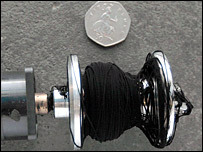
|
| ©Sgt Lorie Jewell (US Army) |
| Future fibers come of age - soldier concept by US Army. |
The researchers say their material is already several times stronger, tougher and stiffer than fibres currently used to make protective armour.
The lightweight fibre, made up of millions of tiny carbon nanotubes, is starting to reveal exciting properties.
Carbon nanotubes are hollow cylinders of carbon just one atom thick.
The new material was developed by a group at the Department of Materials Science and Metallurgy at Cambridge.
It has emerged from efforts to create the world's strongest man-made fibre.
"These nanotube fibres possess characteristics which enable them to be woven as a cloth, or incorporated into composite materials to produce super-strong products," said Professor Windle.
For body armour, the strength of fibres in a fabric is a critical parameter. Strain-to-failure - in other words how much the material can extend before it breaks - is another.
The fibre created in Cambridge is very strong, lightweight and good at absorbing energy in the form of fragments travelling at very high velocity.

|
| ©Alan Windle (University of Cambridge) |
| Carbon nanotube filaments are lightweight but very, very strong. This is what a reel of nanotube fibers looks like. |
"Our fibre is up there with the existing high performance fibres such as Kevlar", said Professor Windle.
But he added: "We've seen bits that are much better than Kevlar in all respects".
The work at Cambridge has already attracted interest from the UK Ministry of Defence and the US Army.
But the new material could also find applications in the area of hi-tech "smart" clothing, bomb-proof refuse bins, flexible solar panels, and, eventually, as a replacement for copper wire in transmitting electrical power and signals.
The method for making the fibre is simple but ingenious.
'Elastic smoke'
A hydrocarbon feedstock, such as ethanol, is injected into the furnace along with a small amount of iron-based catalyst.
Inside the furnace, this feedstock is broken down into hydrogen and carbon. The carbon is then chemically "re-built" on particles of iron catalyst as long, thin-walled nanotubes.
"It makes particles of carbon that are like smoke. But because the nanotubes are entangled, the smoke we make is elastic," explains Professor Windle.
To the eye, this "elastic smoke" looks a bit like an ever-expanding dark "sock".
To begin winding it up, a rod is inserted into the furnace from below to grab one end of the sock and yank it down. This stretches the sock into a filament that can be wound up continuously on a reel.
The researchers are currently seeking funds to investigate whether the method can be upgraded from a laboratory to an industrial process.
Cambridge Enterprise Limited, the commercialisation office of the University of Cambridge, filed an initial patent application in July 2003.
It has now granted a licence to Q-Flo Limited, a university spin-out company, which will exploit the technology.
Nanotubes are graphite which is - along with diamond - one of two common forms carbon takes in nature. In graphite, carbon atoms are bonded in hexagonal structures to form flat layers that are stacked on top of one another like sheets of paper.
When they make nanotubes, scientists are essentially taking individual graphite layers and folding them over so they join at either edge to form cylinders.



Reader Comments
to our Newsletter